







Geoffroy's Cat, named after the 19th century naturalist, Geoffroy St Hilaire, is found throughout southern South America, east of the Andes. With individuals found inhabiting areas around the Straits of Magellan, along with the Puma it is the most southerly of the world's wildcat species.
The spelling of the Geoffroys Cat has also been seen as Geoffrey. As to which is correct, that is not known.
Large adult males can measure up to 9 to 12 pounds. However the body size of Geoffroy's Cat varies considerably throughout its range - cats found in the northern areas are generally somewhat smaller than those found in Southern Argentina and Patagonia. The base fur coloration is also greatly dependent on location. Cats to the north have a ground color of reddish/yellow fur, while cats to the south have gray base coloration, with considerable variation between these extremes through other parts of its range. We have Geoffroys with color ranging from white with dark spots to black with black spots. The cat is marked by small black spots of equal size, spaced evenly over its body. These spots merge into stripped markings around the neck, chest and face. There are also Geoffroys that have spots like flowers (rosetts). In that there is a dark circle with litter color inside the circle. The undersides of the body and chin are lighter and the tail is covered with black bands and usually ending in a solid black tip. The backs of the ears are black with a central white spot except for the melanistic which do not have the white on the back of the ears. Melanistic (black with black spots) cats are sometimes common to the north of the cats range. They are also more common in areas of dense forest.




Geoffroy's Cats are associated with a wide variety of habitat types. However it appears to have a preference for thick cover and scrubby vegitation. This preference for dense ground cover enables Geoffroy's Cat to share much of its range with the Pampas Cat, which is more closely associated with open woodland and grasslands. Geoffroy Cats are also known to share areas with Margays, Ocelots, and Jaguars.
Described as primarily nocturnal, late day and early morning activity have been observed in this predominantly solitary cat. Although spending much of its time, hunting and foraging on the ground, there is much evidence to suggest extensive arboreal activity. Geoffroy Cats are agile climbers and jumpers. Geoffrey's Cat often sleeps in the lower branches of trees.




Mating activity has also been noted to take place above the ground and kittens at the age of six weeks are able to climb well and are fearless of heights as well as many other animals that are larger than they are. Geoffroy's Cat have been described as being good swimmer and able to navigate fast flowing waters.
Territorially, the home range of the Geoffroys Cat is considered small. The female's range being approximately 2.5 km and the males about three times this size - it is common for the range of several females to often overlap. The male's home range is reported to encompass that of several females but not to overlap those of other males. Because of their relatively small home range and general abundance of diverse prey species, in a suitable habitat it is thought that the population of the Geoffroy's Cat could be high if it weren't for the poaching.
After mating, the male takes little part in the raising of the young. The litter size is usually small, between 1- 4 (typically two) kittens and they are born after a gestation period of approximately 72 days. Kittens weigh between 2 and 3 ounces at birth and have been noted to develop quickly. Kittens have also been observed standing at about four days and are often independent of their mother at about eight months.
Hunted extensively throughout its range for its fur, Geoffrey's Cat is one of the most hunted of wildcat species. However, Geoffrey's Cat is still the most highly populated of all South American wild cats and it is possibly due to this large population that as many as 150,000 pelts are traded annually. Approximately 27 Geoffroys Cat pelts are used to make one jacket.
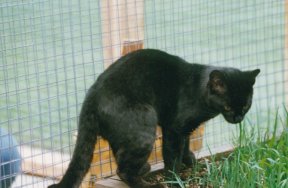


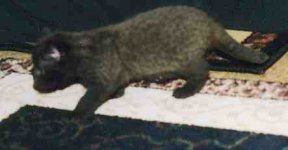
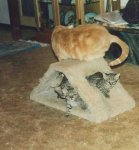
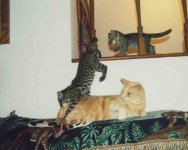
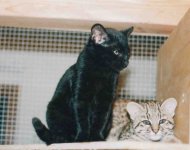
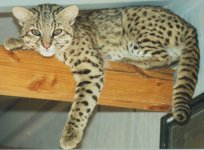
I have to say that the smaller the exotic the more intelligent they are. Our Geoffroys Cats have been observed opening doors, drawers, cupboards, boxes, and anything else that they can figure out. We have installed the child - proof latches as well as magnets to our cupboard doors. We have one little Geoffroy that was/is able to open the child - proof latches so we had to add the magnets as well.
These little guys will steal your heart
From our breeding and research center
If you would like to contact us:Cocoa
Home (Home Index)